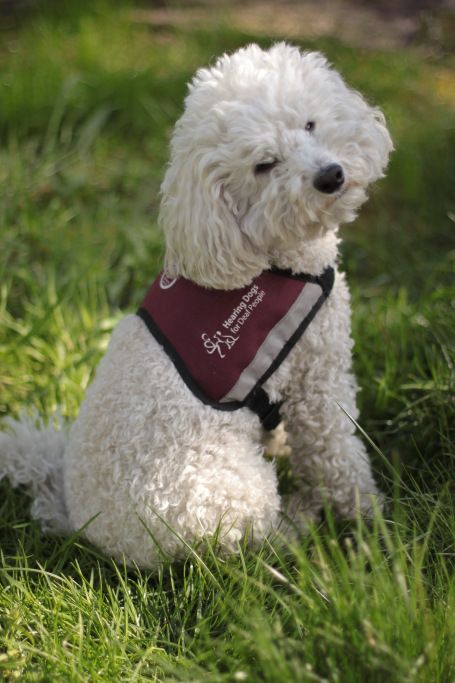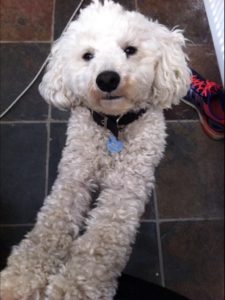Training Hearing Dogs
How to train Hearing Dogs for the deaf
Hearing Dogs for deaf people are a type of assistance dog specifically trained to provide deaf people with improved accessibility to the hearing world. These wonderful creatures can offer greater independence, improve confidence, a feeling of security and of course companionship.
We’ve been talking a lot about Hearing Dogs lately, and I shared many of my personal stories about life with my Hearing Dog, Bailey. In case you missed them:
- How Hearing Dogs help deaf people live happier lives.
- The scandalous refusal to allow a Hearing Dog to enter a restaurant.
- How to safely travel by plane with your Hearing Dog.
Many of you have been asking me how you can get your own Hearing Dog, where to find them, what they cost and how to train them.
I reached out to Maddie Talbot-Jones. Below are her answers to all your questions about training Hearing Dogs.
Frequently asked questions and answers about training Hearing Dogs for the deaf
How long have you been training Hearing Dogs?
I’ve been training dogs for over 10 years now. I started volunteering and working with Hearing Dogs in 2006. I became an official dog trainer in 2008, and I worked my way up to a Senior Trainer. In 2016 I was appointed Training Team Leader.
How does someone become a Hearing Dog trainer?
Successful applicants generally have to be able to demonstrate significant practical and theoretical experience in dog training and behaviour or welfare. Applicants are also required to have good communications skills and experience in working with people with disabilities.
Specialist skills in lipreading, British Sign Language and communication experience with deafblind applicants and/or children are desirable. However, training can be provided.
During my 2006 volunteering, I progressed to a casual staff training assistant role that I did while completing my BSc (Hons) in animal training and behaviour. I also started learning sign language. When a dog training position became available, I applied and went for a formal and practical interview and was successful.
How do you know which dog is a good candidate to become a Hearing Dog?
A dog needs to be sociable and adaptable to various environments and situations. We have a Pup Star Program which all dogs have to go through. We use this program to monitor and keep track of their development and progress.
Throughout the dog’s Pup Star training we’ll continually assess their potential of meeting the Hearing Dog standards and progress to becoming an accredited Hearing Dog.
How are Hearing Dogs trained?
Phase 1: Puppies start with the Pup Star program from 8 weeks old.
They work through simple tasks during their first year, which helps us identify which puppies are having difficulty with certain areas of their training. Every dog is different, and no two puppies will learn the same way.
All dogs are unique with specific strengths, which we work really hard to develop and build upon.
Although we aim for all our dogs-in-training to become registered assistance dogs, some of them take a different but equally important role. When a dog in training is not quite suited to being a full Hearing Dog, we have a number of other options that might suit them better.
The three types of dogs we provide are:
- Full accredited Hearing Dog: With a jacket and full assistance dog access rights.
- Sound support dog: Primarily alerts its owner to sounds and has no access rights.
- Companion and confidence dog: A loyal friend for someone with hearing loss, disability or additional needs.
Phase 2: When the dog is around 16-18 months old
Dogs who continue to work towards becoming a fully accredited Hearing Dog will enter their final phase of training and start to work towards their Hearing Dog Accreditation.
There is a set standard assessment that all Hearing Dogs must attain to move forward to meet their potential recipient.
Phase 3: After meeting their recipient
The dog then continues training for a further 6-8 weeks to tailor their training to fit their recipient’s lifestyle requirements.
Phase 4: Partnership Readiness Check
This is to ensure the recipient’s specific requirements have been met.
Phase 5: Dog and recipient can start their Placement Course
During this phase, the owner will work with the trainer at one of the centres, learning about their new dog and the training they will continue to develop during the early stages of their partnership.
Once the dog and recipient have started their partnership, they then work through Partnership Levels to make sure their partnership continues to grow successfully.
How are Hearing Dogs identifiable when out in public?
A Hearing Dog wears the distinctive burgundy Hearing Dog coat when out in public. This also helps to make other people aware that the person with the dog is deaf, making deafness more ‘visible’.
Hearing Dogs are part of Assistance Dogs UK (ADUK), which means they and their recipients have a legal right to access public places. A Hearing Dog recipient is given an ADUK identification booklet to confirm this when they are out and about.
Can Hearing Dogs access all public places? What does the law say?
Assistance dog owners have important rights under the Equality Act 2010, which provides for people with disabilities to have the same right to services as everyone else.
The Act requires employers, managers of premises and those providing goods or services to make reasonable adjustments.
The Equality Act makes it unlawful for a disabled person to be discriminated against, harassed or victimised or treated less favourably because of their disability or anything connected with their disability, for example, using an assistance dog.
A Hearing Dog has access rights to all public areas when wearing their Hearing Dog jacket. Recipients also carry an ID passport. Hearing Dogs must always wear their jacket and lead slip to identify themselves clearly.
What should businesses know about Hearings Dogs for the deaf?
As a service provider, you will want to make sure you are meeting your obligations under the Equality Act.
- It is unlawful for service providers to treat people with disabilities less favourably because of their disability, or because they have a guide or assistance dog with them.
- Make reasonable adjustments, which might mean guiding someone to their restaurant table and allowing their dog to rest by their feet.
How much does a Hearing Dog cost?
There might be a £50 application fee, but generally, it doesn’t cost anything to have a Hearing Dog. However, you are expected to meet some of the basic criteria:
- You are aged 18 or older.
- You are severely or profoundly deaf in both ears.
- Able to walk your dog for an hour every day.
- Take care of your dog and love it.
- Ensure your dog will not be away from you for more than 4 hours at a time.
- You do not have any other pets at home, except animals older than the age of 10 (in human years).
Although there is no actual cost to get a Hearing Dog, recipients are expected to pay for the general upkeep of having a dog such as dog food, flea treatments and insurance which covers veterinary bills.
If you’d like to volunteer to look after a puppy or care for older dogs in training, or any other volunteer roles, visit Hearingdogs.org.uk to find out more.
Leave a Reply
Want to join the discussion?Feel free to contribute!






Here is a decent book if someone is committed to training their own dog: Lend Me an Ear: Temperament, Selection and Training of the Hearing Ear Dog by Martha Hoffman
Link: http://a.co/2eIJpVV
Indeed, any one can train a dog to help them in some way; BUT only accredited Assistance Dogs UK dogs come under the terms of the Equality Act so a home trained dog could be denied access to public areas.
Wonderful book !!
I’m currently training with Martha Hoffman and her methods and classes are s force free, humane, easy to understand , motivating & inspiring ! Her books wonderful but her online school is Amazing !! First level is Free !!
Thank you.
How much does it cost for a service dog
It is free in the UK.
I am deaf and it’s not so hard to train hearing dogs I have two of my own they know Sign Language even does my cat . Start basic they will grow to understand you and ur needs
Thank you for this comment. My mum is getting a puppy and she is profoundly deaf. We’ve had dogs all our life but my brother and I (both hearing) have trained them. I’ve been getting anxious about how my mum can train the dog but I’ve seen on here and on youtube that she will be just fine to do it on her own 🙂
Im hard of hearing and my 6 year old is deaf. How can we get a hearing dog? We live in Colorado
I am deaf and it’s not so hard to train hearing dogs I have two of my own they know Sign Language even does my cat . Start basic they will grow to understand you and ur needs
I don’t know the costs in the US… but since most insurances don’t pay for aids, then I assume you’d pay out of pocket and then file a tax return.
My question is – has anyone trained their own dog?
Hearing Dogs are free to the recipient in Australia, however, as the dogs are known as Lions Hearing Dogs they must be sponsored by your local Lions Club. This cost the Lions Club approx 1500 a about 17 years ago. I am not sure what the sponsor fee is now?
The training of these dogs costs about $40 000 per dog and usually takes about one year to train.
This article only applies to the UK. In the US, a legitimate professionally trained service dog is considered “medical equipment” and the cost of the dog and all subsequent costs (food, vet care, shots, leashes, crates, etc) are tax deductible as a medical expense.
I trained my own dogs. They are very smart. Now I have a cat too understand sign language too woke me up every morning before my alarm is off
If you live in Australia, you have to be older than 18 in order to get a hearing dog. And there are quite a few more steps before your application is approved. Even if and after you’re approved, there are still many check-ins that are required. Both you and the dog will need to go through training together. Every year, you’ll need to come back in to learn about new tracking and training activities.
You’ll learn more about it in this article: http://www.hearlink.com.au/industry-news/refresher-hearing-dogs/
Not hugely important but something I struggled to find an answer for. Do new owners get to name their dog or has a name already been learned through training?
In the UK, the charity Hearing Dogs for Deaf People will name the dog before training.
I’m 84, should I get hearing service dog? Healthy but old. Thanks